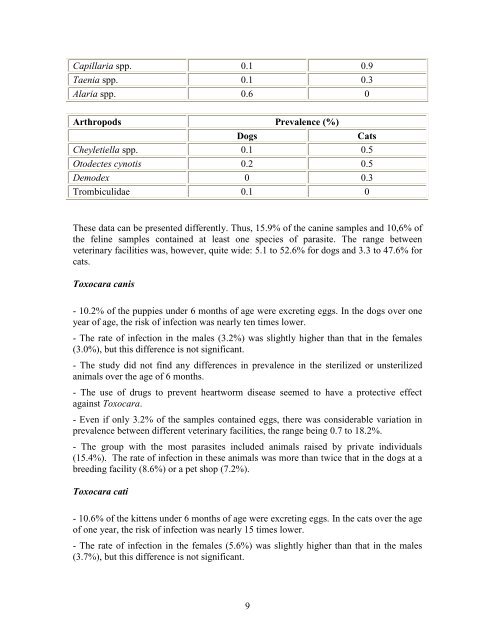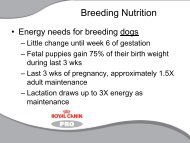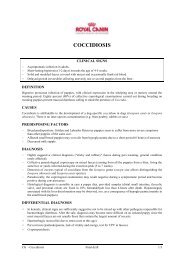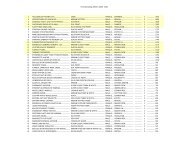Guide to Preventing Parasites.pdf - Royal Canin Canada
Guide to Preventing Parasites.pdf - Royal Canin Canada
Guide to Preventing Parasites.pdf - Royal Canin Canada
You also want an ePaper? Increase the reach of your titles
YUMPU automatically turns print PDFs into web optimized ePapers that Google loves.
Capillaria spp. 0.1 0.9<br />
Taenia spp. 0.1 0.3<br />
Alaria spp. 0.6 0<br />
Arthropods Prevalence (%)<br />
Dogs Cats<br />
Cheyletiella spp. 0.1 0.5<br />
O<strong>to</strong>dectes cynotis 0.2 0.5<br />
Demodex 0 0.3<br />
Trombiculidae 0.1 0<br />
These data can be presented differently. Thus, 15.9% of the canine samples and 10,6% of<br />
the feline samples contained at least one species of parasite. The range between<br />
veterinary facilities was, however, quite wide: 5.1 <strong>to</strong> 52.6% for dogs and 3.3 <strong>to</strong> 47.6% for<br />
cats.<br />
Toxocara canis<br />
- 10.2% of the puppies under 6 months of age were excreting eggs. In the dogs over one<br />
year of age, the risk of infection was nearly ten times lower.<br />
- The rate of infection in the males (3.2%) was slightly higher than that in the females<br />
(3.0%), but this difference is not significant.<br />
- The study did not find any differences in prevalence in the sterilized or unsterilized<br />
animals over the age of 6 months.<br />
- The use of drugs <strong>to</strong> prevent heartworm disease seemed <strong>to</strong> have a protective effect<br />
against Toxocara.<br />
- Even if only 3.2% of the samples contained eggs, there was considerable variation in<br />
prevalence between different veterinary facilities, the range being 0.7 <strong>to</strong> 18.2%.<br />
- The group with the most parasites included animals raised by private individuals<br />
(15.4%). The rate of infection in these animals was more than twice that in the dogs at a<br />
breeding facility (8.6%) or a pet shop (7.2%).<br />
Toxocara cati<br />
- 10.6% of the kittens under 6 months of age were excreting eggs. In the cats over the age<br />
of one year, the risk of infection was nearly 15 times lower.<br />
- The rate of infection in the females (5.6%) was slightly higher than that in the males<br />
(3.7%), but this difference is not significant.<br />
9







